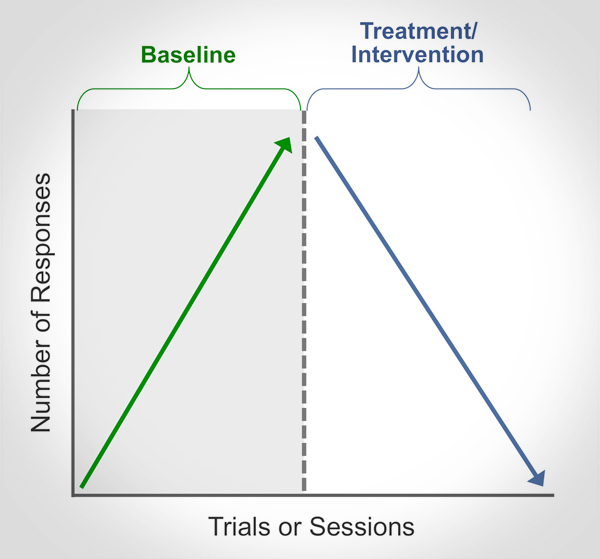Stability and Change
 Getting a baseline of our target behavior before introducing a treatment is essential to assessing the effectiveness of what we are doing, whether it is trying to change a personal bad habit or help someone else become better at whatever it is that they are doing. Only if we know the level of the behavior before we start can we know whether it has changed when we introduce our intervention. The evidence that we have had an effect is all the more compelling if we introduce so-called controls to show that the change comes and goes as we subsequently remove and re-introduce our intervention, but that is a subject for another time. The baseline refers both to the condition and to the behavior during that condition. The behavior during the baseline is considered stable or in a steady state when it varies unsystematically around some average.
Getting a baseline of our target behavior before introducing a treatment is essential to assessing the effectiveness of what we are doing, whether it is trying to change a personal bad habit or help someone else become better at whatever it is that they are doing. Only if we know the level of the behavior before we start can we know whether it has changed when we introduce our intervention. The evidence that we have had an effect is all the more compelling if we introduce so-called controls to show that the change comes and goes as we subsequently remove and re-introduce our intervention, but that is a subject for another time. The baseline refers both to the condition and to the behavior during that condition. The behavior during the baseline is considered stable or in a steady state when it varies unsystematically around some average.
It is perhaps a little ironic that a discipline that is all about changing behavior uses as its primary method one that eschews change and often requires that behavior be unchanging to demonstrate how it changes. But only a little ironic, simply because the method works so well. But all of this does raise the question of what we mean by stable behavior, behavior that has reached what we commonly call a “steady state.”
Steady states are relative, never absolute. Indeed, researchers in the laboratory have examined the long-term effects of exposing pigeons to the identical schedule day after day for up to a year. They found that key pecking rates varied, but usually within a relatively narrow range. And within that range, responding also varied over shorter time periods, again within a range. The variability presumably could be narrowed or widened by changing the conditions under which the pecking was maintained (for we behavior analysts subscribe to the position that variability is a function of contingencies, not happenstance). My point is that we find change – in this case, variability – even under nominally unchanging conditions. Some of this variability may be due to biological fluctuations and other of it to environmental variations (e.g., whether or not there were distractions from the task when the baseline was being obtained), but the practical fact remains that change is an inevitable part of being alive.
It’s important, too, to remember that the steady state is a tool rather than a wavering rule. In a nutshell, its use in behavior is pragmatic rather than philosophical. As a tool, the steady state must reach the “good enough” criterion. Behavior must be sufficiently stable that we can show reliably the effect of our intervention(s). Consider the diagram to the right. If we anticipate that our intervention will dramatically decrease behavior (shown by the arrows inside the graph lines), then our baseline behavior can be increasing day by day and we can still show an effect if the behavior changes as we anticipate. The reverse is true if we expect our intervention to dramatically increase behavior. Usually, however, a middle ground is reached where there are neither increasing nor decreasing trends, and the amount of variability or bounce in the data that is allowed is determined by how much of a change we expect our intervention to have.
behavior is pragmatic rather than philosophical. As a tool, the steady state must reach the “good enough” criterion. Behavior must be sufficiently stable that we can show reliably the effect of our intervention(s). Consider the diagram to the right. If we anticipate that our intervention will dramatically decrease behavior (shown by the arrows inside the graph lines), then our baseline behavior can be increasing day by day and we can still show an effect if the behavior changes as we anticipate. The reverse is true if we expect our intervention to dramatically increase behavior. Usually, however, a middle ground is reached where there are neither increasing nor decreasing trends, and the amount of variability or bounce in the data that is allowed is determined by how much of a change we expect our intervention to have.
The steady state certainly is our best friend when it comes to evaluating how interventions affect change. But it isn’t our only friend, because we also have to consider cases that are the epitome of change, transitions between steady states and transitory states, which we will do in future commentaries.




